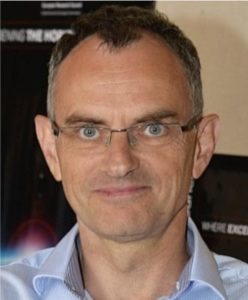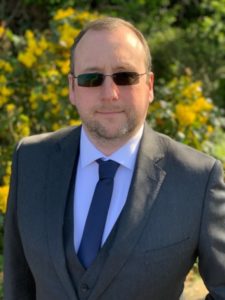Detailed program, abstracts and short bios:
09h00 – 09h40 Aurélien Manchon
Nonrelativistic torque and magnetic Edelstein effect in noncollinear magnets
Abstract: Spin-momentum locking mediated by spin-orbit coupling is responsible for a wide variety of phenomena that are at the basis of the vivid field of spin-orbitronics. Nonetheless, maximizing these effects necessitates the exploitation of materials with large atomic number, which are scarce and expensive. Recently, it has been realized that under certain symmetry constraints, magnetic materials can display momentum-dependent spin-splitting along certain low-symmetry direction of the Brillouin zone, enabling spin-polarized current and Pekar-Rashba-type electron spin dipole resonance. Here, we demonstrate that non-centrosymmetric non-collinear magnets can support current-driven nonequilibrium spin density and torques, even in the absence of spin-orbit coupling. Using group symmetry analysis, model calculations and realistic simulations on selected compounds, we identify large classes of non-collinear magnet candidates and demonstrate that the current-driven torque is of similar magnitude as the celebrated spin-orbit torque in conventional transition metal structure, although in the absence of spin-orbit coupling.
Bio: Aurélien Manchon received his Ph.D. degree in 2007 from University Joseph Fourier at SPINTEC laboratory in France. He worked as a postdoctoral fellow from 2008 to 2009 at University of Missouri-Columbia and University of Arizona-Tuscon in USA. Afterwards, he became an Assistant, then Associate Professor of Materials Science and Engineering at the King Abdullah University of Science and Technology (KAUST), in Saudi Arabia (2009-2019). He is currently a Professor of Physics in the Centre Interdisplinaire de Nanoscience de Marseille (CINaM) at Aix-Marseille University (AMU) since 2019. His research interest spans from quantum transport and spin-orbit coupling in condensed matter, to chiral magnetism, antiferromagnets and ultrafast spin dynamics.
 09h40 – 10h20YoshiChika Otani
09h40 – 10h20YoshiChika Otani
Magnetic Octupole domain wall dynamics in noncollinear antiferromagnets Mn3X (X = Sn, Ge)
Abstract: AFMs possess inherent advantages such as terahertz spin dynamics and low stray fields, making them attractive for domain-wall applications. However, their magneto-electric responses have made it challenging to work with them. Recent studies on noncollinear chiral AFMs Mn3X (X = Sn, Ge) have allowed us to detect and manipulate their magnetic octupole domain states. This study demonstrated that Mn3X can have a fast magnetic octupole domain wall (MODW) motion when driven by an electric current. We have observed that Mn3Ge’s Néel-like MODW can be accelerated up to 750 m s-1, with a current density of only 7.56×1010 A m-2, even without an external magnetic field. The MODWs show high mobility with a low critical current density. Our theory proposes that the MODW motion in noncollinear AFMs results from spin-transfer torque generated by the current-induced nonequilibrium spin accumulation. These findings open up new possibilities for developing antiferromagnetic domain-wall-based applications.
Bio: YoshiChika Otani received the B.S., M.S., and Ph.D. degrees from Keio University in 1984, 1986, and 1989. He was a research fellow (1989–1991) at the Physics Department of Trinity College Dublin, the University of Dublin, and a researcher (1991–1992) at the Laboratoire Louis Néel, CNRS, France. He was an assistant professor (1992–1995) at the Department of Physics, Keio University; an associate professor at the Department of Materials Science, Graduate School of Engineering, Tohoku University (1995–2002); and became a team leader (since 2001) of the Quantum Nano-Scale Magnetics Research Team at FRS-RIKEN. In 2004 he became a professor at ISSP, the University of Tokyo. Since 2013, he has also been a team leader of the Quantum Nano-Scale Magnetism Research Team at CEMS-RIKEN. Prof. Otani has published over 350 technical articles in peer-reviewed journals, including book chapters and review articles, and has given more than 100 invited and plenary presentations at international conferences. He coordinated the Japanese MEXT supporting the 5-year “Nano Spin Conversion Science” project from 2014 through 2019 to elucidate the interconversion mechanisms among phonons, photons, magnons, and electrons. He was also a committee member of C.9 Magnetism of the International Union of Pure and Applied Physics from 2011 to 2017 and vice chair from 2018 to 2021. He is a member of the IEEE Magnetics Society. Since 2022, he has been heading the Franco-Japanese research project developing the “magnon-phonon transducer” as a LANEF chair of Excellence at the University of Grenoble Alpes.
10h20 – 10h40 Break
 10h40 – 11h20 Tomas Jungwirth
10h40 – 11h20 Tomas Jungwirth
Emerging research landscape of altermagnetism
Abstract: Magnetically ordered crystals are traditionally divided into two elementary phases – ferromagnetism and antiferromagnetism. In the first part of the talk, we will recall that the ferromagnetic order offers a range of phenomena for energy efficient IT, while the vanishing net magnetization in antiferromagnets opens a possibility of a breakthrough towards a new-generation IT with ultra-high capacity and speed
[1-3]. In the second part of the talk we will move on to the recent predictions of instances of strong time-reversal symmetry breaking and spin splitting in electronic bands, typical of ferromagnetism, in crystals with antiparallel compensated magnetic order, typical of antiferromagnetism [4-6]. This apparent fundamental conflict in magnetism is resolved by symmetry considerations that allow us to classify and describe a third elementary magnetic phase [7]. Its alternating spin polarizations in both crystal-structure real space and electronic-structure momentum space suggest a term altermagnetism. We will demonstrate that altermagnets combine merits of ferromagnets and antiferromagnets, that were regarded as principally incompatible, and have merits unparalleled in either of the two traditional basic magnetic phases. We will introduce the broad materials landscape of altermagnetism and show how its unconventional nature enriches fundamental concepts in condensed matter physics
[6, 7]. We will show that this underpins a development of a new avenue in spintronics, elusive within the two traditional magnetic phases, based on strong non-relativistic pin-conserving phenomena, without magnetization imposed scalability limitations
[1-9].
[1] T. Jungwirth
et al., Nature Nanotech. 11, 231 (2016),
[2] Z. Kaspar, T. Jungwirth
et al., Nature Electron. 4, 30 (2021),
[3] F. Krizek T. Jungwirth
et al., Science Adv. 8, eabn3535 (2022),
[4] L. Smejkal, T. Jungwirth
et al., Science Adv. 6, eaaz8809 (2020),
[5] L. Smejkal, T. Jungwirth
et al., Nature Rev. Mater. 7, 482 (2022),
[6] L. Smejkal, J. Sinova, T. Jungwirth, Phys. Rev X (Perspective) 12, 040501 (2022),
[7] L. Smejkal, J. Sinova, T. Jungwirth, Phys. Rev. X 12, 031042 (2022),
[8] R. Gonzalez-Hernandez, T. Jungwirth
et al., Phys. Rev. Lett. 126, 127701 (2021),
[9] L. Smejkal, T. Jungwirth
et al., Phys. Rev. X 12, 011028 (2022).
Bio: Head of Department of Spintronics and Nanoelectronics, Institute of Physics of the Czech Academy of Sciences. Professor, School of Physics and Astronomy, University of Nottingham, United Kingdom. Condensed matter physics and magnetism – Hall effects – Nanostructures and nanotechnology – Spintronics and opto-spintronics
 11h20 – 12h00 Richard Evans
11h20 – 12h00 Richard Evans
Atomistic simulations of antiferromagnets for spintronics
Abstract: Antiferromagnets hold much promise for spintronics applications due to their intrinsically ultrafast and inertial dynamics, the ability to mainulate them efficiently with electrical currents, and the lack of stray fields allowing them to be tightly packed at the nanoscale. Despite their promise, the magnetic properties of antiferromagnets are notoriously complicated, with a wide range of observed static and dynamic properties. This is particularly true of the exchange bias effect, where a coupled ferromagnet and antiferromagnet exhibits a shift of the hysteresis loop due to exchange coupling. While pure antiferromagnets offer promise, experimentally determining and measuring their state remains a challenge. In this talk I will outline our recent work on atomistic modelling of antiferromagnets IrMn, PtMn, and Mn2Au including the effects of crystal structure and composition on their static and thermodynamic properties such as Néel temperature
[1] and magnetic anisotropy
[2]. I will share new insights on the origin of the exchange bias effect in the technologicaly relevant IrMn/CoFe system
[3, 4], and the dynamics of MnPt/Pt bilayers and Mn2Au subject to spin-orbit torques. Finally I will outline future developments in atomistic modelling and future challenges in the area of simulating antiferromagnetic devices.
[1] Atomistic simulations of the magnetic properties of IrxMn1-x alloys, Sarah Jenkins, Roy W Chantrell and Richard F L Evans, Physical Review Materials 5 034406 (2021),
[2] Magnetic anisotropy of the non-collinear antiferromagnet IrMn3, Sarah Jenkins, Roy W Chantrell, Timothy J Klemmer and Richard F L Evans, Physical Review B (Rapid Communications) 100 220405(R) (2019),
[3] The atomistic origin of exchange anisotropy in non-collinear IrMn3/CoFe, Sarah Jenkins, Wei Jia Fan, Roxana Gaina, Roy W Chantrell, Timothy Klemmer and Richard F L Evans, Physical Review B 102, 140404(R) (2020),
[4] Exchange bias in multigranular non-collinear IrMn3/CoFe thin films, Sarah Jenkins, Roy W Chantrell and Richard F L Evans, Physical Review B 103 014424 (2021)
Bio: Dr. Richard Evans is Associate Professor at the University of York, UK having completed his PhD in computational magnetism from the University of York in 2008. He has published over 100 articles in international journals attracting over 6000 citations. His research focuses on atomistic models of magnetic materials and the development of the VAMPIRE software package for atomistic spin dynamics.
More information :https://www.spintec.fr/seminar-seminars-on-antiferro-and-alter-magnetic-spintronics/